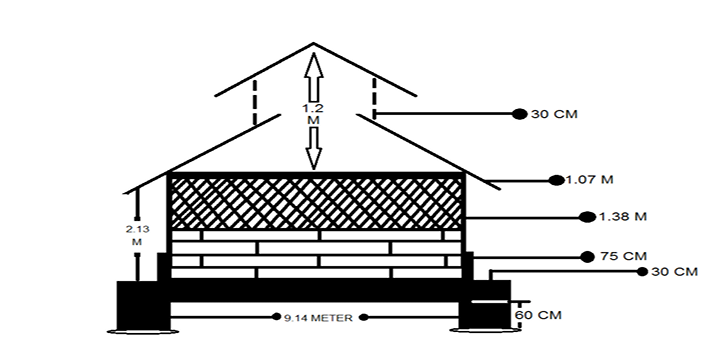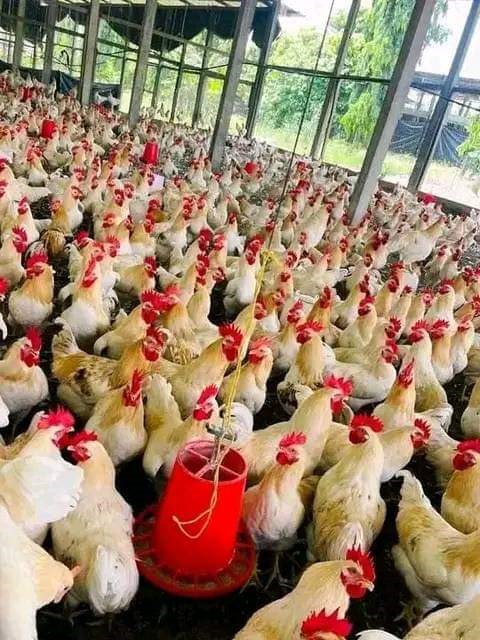Broilers Management
Broiler house condition:
- Size: Each broiler requires one square foot of floor space under deep litter system of rearing.
- Length: Any convenient length, but maximum should be 150 feet for open house.
- Width: Open sided poultry houses should have a width not more than 22 to 25 feet.
- Height: Eaves height from foundation is 7 to 8 feet and Height at centre is 12 to 14 feet.
- Foundation: The depth of the foundation should be 3 to 5 feet.
- Floor: The floor should be concrete, Sloppy with rate proof device and free from dampness.
- Side walls: The side wall should be 1 to 1.5 feet height. The rest to be kept open and fitted with wire mesh or expanded metal. The wire nets should be 2.5 x 2.5 cm (1 inch) size of 16 gauge strength.

Broiler house with ridge ventilation
- Roof: The roof of the shed may be thatched or asbestos sheet. Full monitor and Gable type roof are mostly preferred in tropical countries like India.
- Overhang: Not less than 3.5 feet in order to prevent the entry of rain water into the shed.
- End Walls: End walls on both sides may be closed from roofline to floor level. In small sized houses, wire mesh may be fitted on the end walls as done on the sides.
- Doors: There should be two doors of 1.98 x 0.90 meter (6.5 x 3 ft) size on the end walls. At the entry, a foot bath of the size 45x 90 xs9 cm (1.5x3x0.4 ft) should be constructed.
- Lighting: Light should be provided at 7 to 8 feet above the ground level and must be hanged from ceiling. For incandescent bulb, the interval between two bulbs is 10 feet and in case of fluorescent light (Tube lights) the interval is 15 feet.
Optimal environmental condition for broilers:
| Temperature | 220-300 C (70- 850 F) |
| Relative humidity | 30-60% |
| Ammonia level | 25ppm |
| Width | 15-25% |

Practices to be followed in successful broiler production
In deep litter system of management, litter materials may be rice husk, saw dust, ground nut hulls, wood shavings etc. Depth of litter should be 3-6 inches. Broilers should be reared in All-in-all out system (single batch at a time).
- Preparation of brooder house to receive the chicks
- Remove all portable equipments, clean and wash then, dip them in any suitable disinfectant as per manufacturer’s instruction and then sundry for a day.
- Remove all organic material preferably after spraying 5 to 10 % formalin and dispose it off away from farm premises.
- Heat treatment – burning of floor, side wire mesh with blow lamp to reduce coccidiosis.
- Chemical Treatment- Soak floor with strong solution of caustic soda flake for 12 to 24 hrs to kill VVIBD virus. Dose of NaOH-11 -12 gm per lit of water, or 2 kg per 1000 sq feet.
- White wash- Lime stone + 2 to 5 % formalin + 1 % copper sulphate + 1 % kerosene
- Fumigation- 20 gm of KMnO4 + 40 ml formalin for 100 cu feet.
- Keep the shed vacant for 7 to 10 days
Brooding space: The ideal number of chicks under each brooder will be 250-300 chicks. A minimum brooder space of 150 cm2 should be provided per chick brooder in deep litter up to 2 weeks of age.
Lighting Management: Provide 24 hours lighting during brooding period, followed by 23 hours and one-hour darkness per day until marketing. For brooding period, intensity of one-foot candle or 11 Lux units at birds eye level i.e. provide one 40 watt incandescent (round) bulb at 2.4 metres height with reflector for every 20 sq.m area. After the brooding period, about 5.5 Lux or 0.5 foot candle at bird’s eye level.
Feeding management:- Feed should be given within one hour after the chicks are placed in brooder by sprinkling it over the entire area covered by newspaper and encircled by the chick guard.
- After a few hours, feed should be given on Chick feeder plate or shallow trays or tyre feeder during first week.
- As the birds grow, their feeding space requirement also increases and thus, smaller feeders should be replaced with larger ones from 3rd week onwards.
- Shaking of feed should be done every hour regularly to attract the birds towards fresh feed. Feed should be easily available to the birds.
- Distance between two feeders should not be more than 5 feet.
- The height of feeder should be adjusted at the level of back of the bird.
- chick plate/ tyre feeder for 50 – 60 chicks (1st Week) 1 chick feeder for 50 – 60 chicks (1 to 3 weeks) 1 feeder for 30 – 40 birds (4 to 6 weeks)
- During hot weather (June, July and August) feed should be provided during early morning and evening only to prevent death due to heat stroke.
- Feed should be procured for about 15 days period of use only.
Drinking water for broiler should be soft, clear, fresh, clean, colourless and free from any kind of odour. Contaminated water is mostly responsible for a number of problems in causing diseases like Colibacillosis, Coccidiosis, Salmonellosis, Enteritis, Ascitis, Septicaemia, Hepatitis etc.
In cool weather, broilers drink about 2 litres of water for every kilogram of feed they consume. In hot weather, the ratio can be increased to as much as 4 litres of water for one kilogram of feed. As a thumb rule, one can determine the approximate water requirement by multiplying the age of the bird in weeks by 2, the resulting figure would be litres of water per 100 chicks. e.g. 2 × 5 = 10 litres / 100 broilers at 5th week
Important tips of watering:- At no stage, water trough should be allowed to become dry.
- The maximum distance between 2 waterers should be 8 ft.
- Waterers should be placed daily at different sites.
- All the waterers must be washed nicely with a detergent powder daily in the morning before filling.
- Water reservoirs should be disinfected at regular interval.
- Waterer height should be adjusted at the level of back of bird.

